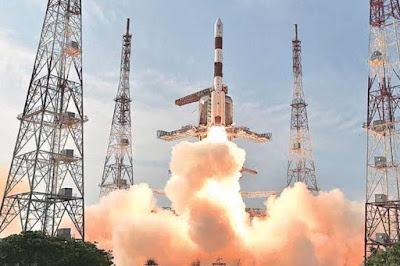Indian Space Research Organisation (ISRO) on 28 April 2016
launched India’s seventh navigation satellite of the Indian Regional Navigation
Satellite System (IRNSS 1G) into a Sub-Geosynchronous Transfer Orbit (Sub-GTO)
on-board PSLV-C33. The satellite was launched from the First Launch Pad (FLP)
of the, Satish Dhawan Space Centre, Sriharikota, which is situated 90 kms from
Chennai. With this launch, India successfully joined the elite group of
countries that have their own navigation system technology to cater to the
mammoth navigational needs. As in the previous six launches of IRNSS satellite,
PSLV-C33 used ‘XL’ version of PSLV equipped with six strap-ons, each carrying 12
tons of propellant.
 Features
of IRNSS:
Features
of IRNSS:
·
Its consists of seven satellites to provide real
time data on the position of objects to aid road, air and maritime traffic
apart from providing mapping and tracking services.
·
It is an independent regional navigation
satellite system designed to provide position information in the Indian region
and 1500 km around the Indian mainland.
·
It would provide two types of services, namely,
Standard Positioning Services (SPS), which will be provided to all users and
Restricted Services (RS) that will be provided to authorized users only.
·
Out of the seven satellites of the system, three
are geostationary and four are non-geostationary.
·
By using the IRNSS as a platform, the Government
of India is planning to launch its own Global Navigational Satellite Services,
GINS (Global Indian Navigation Satellite) system. It is similar to the Global
Positioning System (GPS) of the USA.
While many countries in the world have more than 20
satellites in serving the navigational purpose Indian scientists can boast of
by achieving the goal by launching the seventh satellite which in a way
completes the constellation which was earlier planned. This constellation will
help ISRO to take help from the civilian needs to security or defense needs. The
Prime Minister Narendra Modi who congratulated ISRO for the launch termed the
system as NAVIC (Navigation with Indian Constellation). This launch also made
into the selected nations that have their own GPS (Global Positioning System) or
Navigation system.
The other
selected countries in the league includes:
·
US Air Force owns Global Positioning System
(GPS)
·
Russian owns GLONASS
·
China owns BeiDou, which is expanding into a
global system. It is also operated by its military.
·
Europe – GALILEO is a civil global system.





